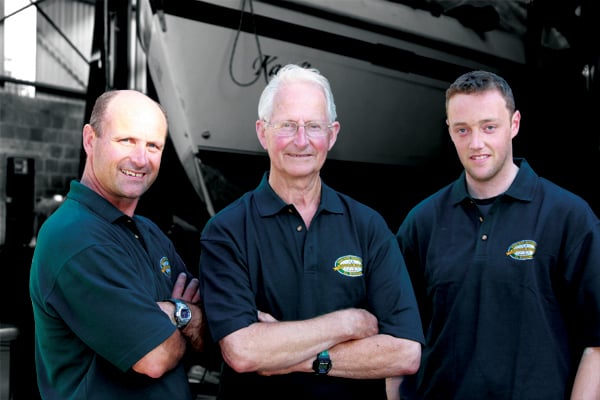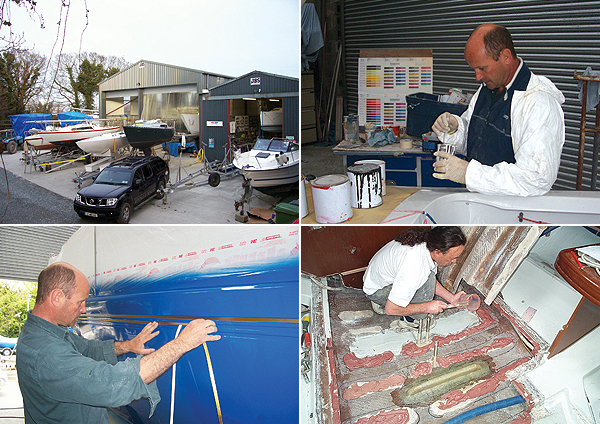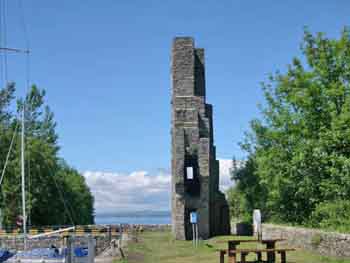Displaying items by tag: boats
Wicklow Boatyard at the Cutting Edge
Afloat magazine profiles Noonan Boats, one of the country’s leading repair facilities
From collision damage, keel fairing right up to osmosis treatments and re-sprays, Noonan boatyard in Newcastle, Greystones Co. Wicklow offers such a comprehensive service on the East Coast there is little need for any boat to go abroad for repairs these days, regardless of the extent of damage.
And news of the quality work has been spreading with boats from the four coasts Ireland coming to Wicklow for a range of work.

Graeme Noonan (left) has extensive big boat repair experience from his time in the marine industry in Sydney, Australia and is an active RS sailor. Founder Tony Noonan (centre) has spent a lifetime in the Irish Marine industry with Neil Watson Yachts, Wicklow Marine Services before setting up Noonan Boats in 1995. Brian Flahive is an active dinghy and keelboat sailor this year finished second in the Round Ireland double-handed class and won the Fireball National Championships.
Father and son team Tony and Graeme Noonan have over 30 years in the business and have recently expanded the premises to over 3,000 sq feet to cater for a growing range of repair work for boats up to 50 feet under cover.
They have a well-established reputation for the treatment of osmosis, to resolve hull blistering. This is a preventative and remedial process that requires specialist treatment.
The bulk of repair work comes from along the East Coast based boats and the nearby port of Dun Laoghaire but the company offers a national service to include transport to and from the Noonan boatyard if required.
“We have an established track record dealing with Insurance companies. No job is too difficult, too small or too big for us” says Tony Noonan.
Most work is carried out in in a purpose-built marine workshop containing two lifting bay facilities that includes keel and rudder repair pits but the firm also carries out on site repairs to suit too.
Repairs are carried out to original specifications and they carry out re-moulding repairs to up to date construction methods e.g. GRP foam core, Balsa core and carbon under vacuum bagging conditions.
A particular speciality is the repair of carbon repairs to dinghy masts, spinnaker poles and hulls. This has become more popular recently with the advent of carbon bowsprits on boats such as the J109s and SB3s.
Keel fairing, the process of improving the accuracy of the shape of a keel to improve boat speed is also high on the jobs list.
The company also has the specialist hot weld equipment to carry out the repair of polyethylene materials as used in the RS Feva and Laser Pico dinghies.

Colour Matching
Making a fibreglass repair to bring a boat back to original specification is one thing but matching gel coat to weathered or faded paintwork is quite another. Noonan Boatyard cosmetically match gels to present colour so the repair can appear practically invisible.
Polyethelene Repair
Plastic boats are durable but they can split and crack. Repairing them requires specialist heat gun welding equipment
Repair and re-spray
Weathered topsides, especially darker colours, always benefit from a re-spray, tired areas including decks and non-skid areas can also be re-sprayed
Floor matrix repair
After a keel grounding with rocks, for example, damage to a floor matrix may not be immediately visible but it is vital that inner frames are checked and repaired
Osmosis treatment, hot vac and copper coat
The yard uses the latest technology in the treatment of osmosis. Hulls are gel-planed to expose lay up prior to a HOT- VAC process and drying. This can be the stage where copper coat is an economical choice. It ends the need for the expensive and unpleasant annual chore of cleaning and repainting a boat’s hull. Simply hose down the hull at regular intervals, commonly once a year, to remove any build-up of sea-slime. We currently have two examples in our yard at present which show after one year and after ten years of immersion – and still working. Come and see for yourself!
Fully Repaired, Tried and Tested
Noonan Boats completed extensive repairs to Oystercatcher, a Gibsea 37, and when this work was completed the firm entered the boat in the gruelling 704-mile race round Ireland.
Local sailors Brian Flahive (Fireball National Champion) who works at the yard and Bryan Byrne manned what was Wicklow Sailing Club’s first ever yacht to entry into the doubled handed class of the Race. Dubbed the ‘Pride of Newcastle’ the entry finished an impressive winner of IRC III and Cruiser Class IV. The pair also finished second in the two handed class.
It was no easy journey but certainly the repairs stood up to the job, a case of repair work being tried, tested and proven!
The Boatyard, Sea Road, Newcastle, Greystones, Co. Wicklow
Tel/Fax: 01 281 9175 • Mobile: 086 170 8875
Email: [email protected]
- boats
- Wicklow
- RS Feva
- Dun Laoghaire
- Greystones
- collision
- Brian Flahive
- noonans boats
- wicklow boatyard
- boat repair
- keel fairing
- osmosis
- Newcastle
- Neil Watson
- Graeme Noonan
- Tony Noonan
- repair
- hull blistering
- Insurance
- lifting bay
- workshop
- GRP
- vacuum bagging
- carbon repairs
- dinghy masts
- spinnaker poles
- Laser Pico
- Polyethelene Repair
- respray
- Floor matrix
- hot vac
- copper coat
- Repaired
- damage
Good Tips for Beginner Boat Buyers
So you're taking the plunge and buying your first boat, but you don't know where to begin.
Luckily there's a host of hints and tips online to guide boating novices towards their first purchase, and the latest guide at Cool Articles is no exception.
The Beginners Guide for New Owners breaks things down into a simple list of everything new boaters must consider - from finding the type of boat that best fits your needs, to finding the right dealer at the right price, and understanding what owning a boat really entails.
See more of Buying a Boat - Beginners Guide for New Owners at http://travel.coolarticles.org/buying-a-boat-beginners-guide-for-new-owners/
Greystones Motor Yacht Club
Greystones Motor Yacht Club
Do you own a power boat or a yacht?
Do you moor or berth it elsewhere because of the poor condition of Greystones harbour?
Is it your intention to keep your boat at the new Greystones harbour?
Do you like having fun?
If you have answered ‘yes’ to the above four questions then we have some good news for you. As you will be aware a vibrant new community harbour and marina is to be built at Greystones. We welcome this improvement and all the facilities that are being put in for the existing clubs and for the general public who will be able to enjoy this great addition to our town.
We intend to set up the Greystones Motor Yacht Club. The purpose of this club will be to cater for the needs of both motor boats and yachts. As it stands there is no club for us to join in Greystones so it is our intention to start such a club.
Setting up the Greystones MYC has commenced but will take some time. However if you are interested in becoming a member please register your interest by emailing your details to us.
Greystones Motor Yacht Club, Greystones, Co. Wicklow. Tel: 085 788 9544 or email: [email protected]
or c/o Michael Quinn, 20 Main Street, Bray, Co. Wicklow. Tel: 086 2675382, 01 282 9541, or email: [email protected]
Have we got your club details? Click here to get involved
Lough Derg Jetski Club

Lough Derg Jet Ski Club
Lough Derg Jet Ski Club has become a reality thanks to a group of Jet Ski enthusiasts who are trying to safeguard the future of their sport, for themselves and for future generations.
After hearing the possibility/reality that Personal Water Craft (PWC) and powerboats were going to be banned on our waters, we came to a conclusion that if weren’t proactive about the future of our sport, and build a better relationship with both the general public, local authorities and other users on the water the inevitable was going to happen.
A committee was formed on the 26/03/2008 and with the help from Denis Dillon, the Motorboat Development Officer of the ISA, various channels of communications were opened with Waterways Ireland, Local Councils and the Irish Sailing Authority (the national body for boating in Ireland who are actively encouraging and promoting clubs in Ireland) and other authorities.
From general feedback from local authorities we understand that they don’t actually want to ban our crafts but it is necessary for them to be able to control and manage their use - which is not possible on an individual basis. In the UK the PWC users were looking at a similar ban until they formed clubs and took responsibility for their sport and became accountable to uphold certain standards, rules and regulations for their members.
Our Aim is to secure the future of our sport by developing our relationship with the relevant authorities, to show them that by promoting safe and considerate use of PWSs within club structures, is the way forward, to benefit all involved.
Club mobile – 087 6614521
Chairperson – Alan Mooney – [email protected]
Safety Officer – Martin Tierney – [email protected] – 086 066 4137
Treasurer – Jon O'Shaughnessy – [email protected] – 086 2255 904
(The above information and image courtesy of Lough Derg Jetski Club)
Lough Derg Jetski Club, Lough Derg Jet Ski Club, Ballina, Co. Tipperary
or c/o Joe Doolan, Secretary, Forthenry, Ballina. Tel: 087 661 4521, email: [email protected]
Lough Swilly Yacht Club

Above: the crew of Cork at the beginning of the Clipper Race 2009
Lough Swilly Yacht Club
Lough Swilly Yacht Club is based in Fahan Creek on the shores of Lough Swilly, Co Donegal, three miles from Buncrana and ten miles from Derry.
Our membership consists of IRC-racing and cruising sailors as well as powerboat enthusiasts and some keen dinghy sailors. All club members enjoy spending time pottering about on the lough and many like to venture further afield; either to cruise or to represent the club in competition (see the Ships' Blog section for more).
Club History
The Lough Swilly Yacht Club was founded in February, 1955, when a meeting took place in the old City Hotel, with a view to forming a 'club' to encourage sailing and power boating in Lough Swilly by every possible means.
The first Officers of the club were: Commodore Dr. T.E. Hastings. Vice Commodore James McColgan. Rear Commodore Stephen Faller. Secretary Mayne Elliot and Treasurer Norvall Watt. A Committee was set up of men who between them had a wealth of sailing experience and whose enthusiasm and sheer hard work laid the firm foundation of today's thriving club.
The club was fortunate to have as a founder member Mr. James Whyte, Manager of the Lough Swilly Railway Co. and when the railway line from Derry to Buncrana closed in 1953 the club was able to purchase for a very nominal sum the old station waiting room and ticket office, as well as a considerable amount of ground where the old railway line ran beside the water's edge. This formed the nucleus of the present club and in subsequent years the slipway was built and extended, the caravan site erected and the clubhouse itself took in the old station house.
The first racing took place at 3.30pm (Swilly time) on Opening Day, Saturday 2nd July 1955, and there was a fine turnout of miscellaneous craft. After the day's racing all members and friends were invited to afternoon tea at the temporary club premises on the Railway Station Platform in Fanad, durning which prizes were awarded.
(The above information and image courtesy of Lough Swilly Yacht Club.
Lough Swilly Yacht Club, c/o Karen Sleat, Fahan, Lifford, Co Donegal. Email: [email protected]
Garrykennedy Sailing Club

Garrykennedy Sailing Club
Garrykennedy Sailing Club was founded in The Barge Inn, Garrykennedy (now Larkins) in the first week of September 1985. The subscription was set at £5 and twenty people became members. Willie McGrath was the first Commodore. The first series prize was donated to the club by Joe Reynolds in memory of the late Eddie Regan and was sailed for in October of that year. The boats sailing ranged in length from 17ft to Jubilee B at 33ft. During that series there were about 12 boats in the fleet.
Left: Garrykennedy Castle
(The above information and image courtesy of Garrykennedy Sailing Club)
Garrykennedy Sailing Club c/o Jim Hughes, Garrykennedy, Portroe, Nenagh, Co Tipperary. Tel: 067 23001, email: [email protected]
Have we got your club details? Click here to get involved
Dungarvan Harbour Sailing Club

Dungarvan Harbour Sailing Club
Dungarvan has always been noted for its sailors and its great sea-faring families and the tradition of the bygone days of the coastal schooners is reflected there today in the strong active sailing club which was founded at a public meeting in the Town Hall on Friday 2nd August 1946. The first officers were Bernard Mulcahy, Commodore, Reveille Farrell, Vice Commodore, Maurice Kiely, Secretary and Joe Donovan, Treasurer.
Left: The Clubhouse
The inaugural race of the club, for the newly presented Mulcahy Cup, was held over a 6½ mile course with a fleet of four boats; Mairead built by Tyrells and owned by Bernard Mulcahy, Maise formerly of Dublin owned by Maurice and Peter Kiely, Naomh Breandáin owned by Gerard Walsh, and Jane Shore owned by James Villiers Stuart. The race was won by Maurice and Peter Kiely.
Helvick based boats then showed an interest and these craft, mostly gaff rigged salmon boats crewed by fishermen from the Helvick and Ring Gaeltacht, were usually well placed. Amongst these 'Pauls Boat' and 'Slatterys Boat' were outstanding, leaving the 'yachts' a poor second on more than one occasion.
In 1948 Reveille Farrell bought Susanna, a nine-ton Bermudan cutter designed by Norman Dallimore and built in 1936. She was to become well known for her many cruises to the West Coast of Ireland, in the English Channel, and Brittany. The most famous of these was in June 1957 when accompanied by Gerard Walsh and John Ballot she sailed to Spain and back. This was a considerable achievement at the time as it was believed that the passage across the Bay of Biscay and back again was beyond the capacity of the average cruising yacht in the normal holiday period. Coincidental with the arrival of “Susanna” some of the older boats changed hands and were lost to the club and big boat racing activity declined. They were replaced by a number of one man canvas sailing canoes, owned and frequently capsized by Col. Jack Hockin, Maurice Kiely, and Tim MacCarthy – which were the beginnings of dinghy sailing in Dungarvan Harbour.
During the winter of 1958, John and Austin Flynn built a 16’ hard chine Petrel class dinghy from plans in an American magazine. Because the design was ideally suited for home construction many Petrels quickly followed and dinghy sailing really became established in Dungarvan. There was great rivalry and competition in the fleet and each new boat came with a further refinement or new 'secret weapon' not seen on previous models. Construction methods changed from larch planking and cotton sails to plywood and terylene. In all 50 boats of the class are known to have been built, the later ones of GRP construction. An unfortunate drawback of the Petrel was the fact it was unique to Dungarvan and those interested in inter club competition had to look to other designs to compete nationally.
GP14s were popular for a while during which period the club hosted the Purcell trophy. Nowadays the dinghy fleet comprises of Wayfarers, Lasers, Mirrors and Toppers sailed by a very active junior section.
The cruiser fleet has also expanded and the burgee of DHSC has been carried far afield and its members have logged many miles from Cape Horn to the Northern Latitudes.
Although once a busy commercial port, Dungarvan in common with many other ports of its size suffered when changes in shipping practices led to a decline in the number of vessels using the port and with trade totally finished many of the old warehouses along the quayside became derelict. Reconstruction has injected new life into this area of the town and created the opportunity for Dungarvan Harbour Sailing Club to acquire a site on the quay front on which to build a clubhouse which is now the focal point of club activities.
The Town Council is currently progressing the construction of a marina, which together with the abundance of new restaurants and other onshore facilities available will firmly establish Dungarvan as a compulsory stopover for cruising yachts and greatly ease the current shortage of mooring space in the harbour.
DHSC is a family orientated club. Visitors by road and sea are welcome. Pontoons at quayside. Showers and toilets available in the Clubhouse to visitors. The Clubhouse and bar are open at the weekend from 5pm throughout the year, dinghy and cruiser racing and cruising in company during the summer.
(The above information and image courtesy of Dungarvan Harbour Sailing Club)
Dungarvan Harbour Sailing Club, c/o Andrew Corby, Davitt's Quay, Dungarvan, Co Waterford. Tel: 058 45663, email: [email protected]
Have we got your club details? Click here to get involved
Buccaneer Powerboat Club
Buccaneer Powerboat Club
Buccaneer Powerboat Club, c/o Stephen Taylor, Albatross, Kinsealy Lane, Malahide, Co. Dublin. Tel: 087 239 3054, email: [email protected]
Have we got your club details? Click here to get involved
Ballinduff Bay Watersports Club
Ballinduff Bay Watersports Club
Ballinduff Bay Watersports Club, c/o Keith Collins, Grange, Corrandulla, Co Galway. Tel: 086 601 9862, email: [email protected]
Have we got your club details? Click here to get involved
Crookhaven Harbour Sailing Club

Crookhaven Harbour Sailing Club
CHSC was founded in 1979 to provide sail training for junior sailors. ISA courses (level 1–5) are held every July. A new modern clubhouse with showers facilities available to all visitors. Pontoon berths available. Laser all rigs, Mirrors and 1720s.
Dinghy courses offered up to Improving Skills, Advanced Boat Handling, and Racing 1.
(The above information and image courtesy of Crookhaven Harbour Sailing Club)
Crookhaven Harbour Sailing Club, c/o Vivian Nathan, 4th Floor, The Atrium, Blackpool Business Park, Blackpool, Cork. Tel: 021 421 7940, emails: [email protected] or [email protected]
Have we got your club details? Click here to get involved






























































